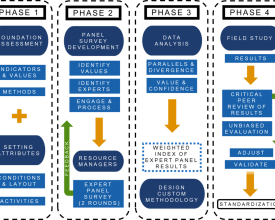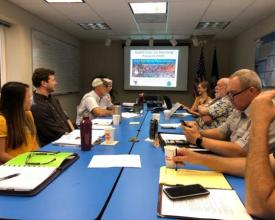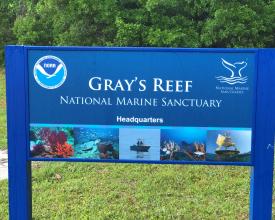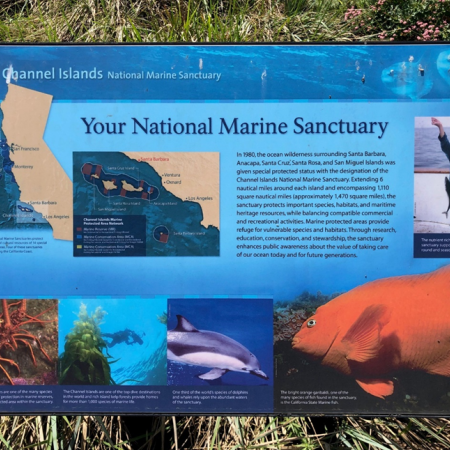
El proceso de recuento de visitantes de los Santuarios Marinos Nacionales: Un proceso de información para la gestión de áreas marinas protegidas y el desarrollo comunitario
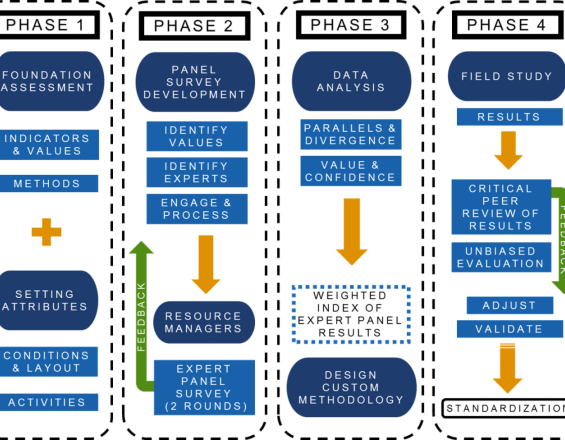
A través del Proceso de Recuento de Visitantes de los Santuarios Marinos Nacionales (NMS-COUNT), los gestores de recursos de las áreas marinas protegidas (AMP) obtienen datos y métodos válidos y fiables para avanzar en la capacidad de predicción y la comprensión de los visitantes. El proceso NMS-COUNT es un marco iterativo que permite a la gestión local y a las partes interesadas añadir conocimientos sobre el uso de los visitantes en una unidad del NMS a través de cada fase.
Basándose en el Marco Interinstitucional de Seguimiento de Visitantes de EE.UU., NMS-COUNT facilita la aportación local sobre visitas y la comunicación con gestores e investigadores para desarrollar y aplicar la metodología más eficaz. Entender el uso que hacen los visitantes puede ayudar a los gestores de las AMP a crear mejores políticas, lo que redundará en visitantes más satisfechos y ecosistemas costeros más sanos. Los datos sobre visitas ayudan a mantener y gestionar eficazmente los recursos ecológicos, económicos y sociales locales. NMS-COUNT ayuda a los gestores de recursos a respetar los límites de resistencia dentro de las AMP, lo que conduce a un uso y mantenimiento sostenibles para las generaciones futuras.
Contexto
Défis à relever
En Estados Unidos, más de 172.481 millas cuadradas de aguas marinas y de los Grandes Lagos están designadas como Santuarios Marinos Nacionales. El sistema de NMS consta de 14 zonas marinas protegidas y sirve de puente para la exploración de recursos naturales, la educación, el ocio, el turismo y muchos otros servicios ecosistémicos. Aunque varios grupos federales, estatales y tribus de tratados costeros colaboran en la gestión de las zonas costeras y marinas, existe poca compatibilidad en los métodos de estimación de las visitas. Los santuarios varían en tamaño, pueden estar situados a lo largo de la costa o carecer de límites físicos cuando se encuentran en alta mar. Esta diversidad de ubicaciones geográficas plantea retos únicos para el recuento de visitantes, especialmente cuando la recogida de datos debe ser rentable. Por lo tanto, un enfoque general que no incorpore detalles específicos del lugar en el muestreo y la estimación de las visitas no sería aconsejable.
Ubicación
Procesar
Resumen del proceso
El proceso NMS-COUNT implica a investigadores, científicos de agencias y gestores en un proceso iterativo de cuatro fases: 1) investigación e identificación de métodos de estimación de visitantes aplicables a un sitio específico, 2) panel de expertos para aportar información sobre métodos específicos del sitio, indicadores de uso (sociales, ambientales, temporales, intensidad espacial, etc.) y niveles de confianza, 3) desarrollo de una metodología específica del sitio y plan de muestreo, y 4) pruebas y análisis de campo.
En cada fase, se analiza la confianza de los métodos en la producción de estimaciones de visitantes que sean eficientes, válidas y fiables, y se adaptan mediante retroalimentación a lo largo de cada iteración sucesiva. Las iteraciones entre las tres fases dan como resultado final un consenso científico sobre los objetivos cuantitativos para medir el uso de los visitantes con un nivel de confianza acordado. Si bien NMS-COUNT aporta valor y contribuciones técnicas a través de sus fases, el uso óptimo del proceso dependerá del contexto y de la colaboración a nivel de sitio y regional. Un objetivo futuro es aplicar NMS-COUNT en otras áreas marinas protegidas y en cualquier zona en la que el turismo pueda depender notablemente del contexto.
Bloques de construcción
El marco iterativo NMS-COUNT: Fase 1
En la Fase 1, los investigadores revisan la bibliografía para obtener un conocimiento exhaustivo de los métodos de muestreo, estimación y seguimiento de visitantes en diversos entornos. A partir de esta investigación, se identifican los métodos potenciales y los tipos de datos que producen, así como las ventajas y desventajas de utilizar cada método a diferentes escalas. Para examinar qué métodos e indicadores de frecuentación son más eficaces en un SMN elegido, se inventariarán todos los atributos del lugar, las actividades de los visitantes y las condiciones (sociales, biofísicas, normativas, espaciales y temporales, etc.) del santuario. A continuación, los investigadores determinan qué métodos son potencialmente apropiados para ese santuario en concreto, en un rango de niveles de confianza (de bajo a alto). El Santuario Marino Nacional de Gray's Reef se utilizará como ejemplo para comprender mejor NMS-COUNT a lo largo de esta solución.
Factores facilitadores
En esta fase se requiere un alto grado de interacción por parte de los investigadores. Durante la Fase 1, los investigadores reunieron y recopilaron materiales para comprender el trazado, los atributos, las condiciones y las actividades recreativas declaradas del lugar. Los investigadores deben llevar a cabo una evaluación básica para comprender plenamente los indicadores y normas establecidos para la gestión del área protegida, los valores asociados al entorno y cualquier atributo del entorno que sea único y que no permita su reproducción en otros entornos.
Lección aprendida
Se identificaron dos actividades principales en Gray's Reef: el buceo y la pesca, siendo la principal la pesca recreativa. Esto ayuda a informar el proceso NMS-COUNT con fuentes de datos focales que identifican el volumen, la frecuencia y el impacto de este tipo de visita dominante. Algunas fuentes de datos existentes informan el proceso, como los recuentos de visitas captados por otros métodos de encuesta (por ejemplo, patrullas policiales, sistemas automatizados de identificación de embarcaciones, etc.). Más allá de las fuentes de datos existentes, los métodos potenciales de estimación de visitantes examinados para este entorno de área protegida totalmente en alta mar fueron los drones lanzados desde embarcaciones, los aviones de ala fija y las encuestas in situ.
El marco iterativo NMS-COUNT: Fase 2
La fase 2 reúne a diversos gestores de organismos, partes interesadas locales e investigadores para abordar un conjunto de objetivos de gestión y necesidades de seguimiento asociadas. En este proceso de colaboración, todas las partes interesadas aportan sus conocimientos y perspectivas sobre los mandatos legales, las políticas y los factores que influyen en las visitas y el uso de un santuario concreto. Los gestores y los informadores locales participan en una serie de encuestas y talleres que progresan desde un cuestionario de base más amplia a otro con preguntas más específicas basadas en comentarios previos. El grupo de expertos analiza las tendencias de los visitantes y los retos específicos del seguimiento de las visitas en su lugar. Los resultados de cada encuesta iterativa y taller proporcionan una visión detallada del estado actual de los conocimientos sobre las visitas y el nivel de confianza en las formas en que se ha obtenido esta información.
Factores facilitadores
La fase 2 requiere un compromiso pleno entre los gestores locales y los investigadores. Cuando los gestores implican a las partes interesadas locales y les informan del proceso, la información facilitada a los investigadores es más completa. Esta parte del proceso se basa en el desarrollo de relaciones interpersonales entre investigadores y partes interesadas. El desarrollo de estas relaciones de trabajo a través de contactos en talleres y otras interacciones ayuda a establecer una base de confianza y cooperación para que el proceso NMS-COUNT siga adelante.
Lección aprendida
En la Fase 2, el equipo de investigación se puso en contacto con gestores y partes interesadas para conocer mejor el estado actual de las visitas al santuario. En colaboración con la Oficina del SMN de la NOAA, los investigadores tuvieron acceso a 32 gestores de recursos locales y partes interesadas con conocimientos institucionales sobre el lugar. De este modo, el equipo de investigación pudo elaborar una encuesta y reunir a los interesados locales en un foro. A todos los interesados se les envió un cuestionario inicial en el que se les pedía su opinión sobre las visitas al santuario en general. Tres interesados respondieron al cuestionario, proporcionando información general sobre las actividades de los visitantes, los patrones temporales y espaciales de uso, las vías de acceso al santuario y a través de él, y el estado actual del recuento de visitantes. A partir de esta información, se elaboró una segunda ronda de cuestionarios para el taller. El taller presencial incluyó debates detallados sobre los retos identificados para el control de las visitas en el SMN de Gray's Reef. También permitió un debate detallado sobre la disponibilidad de datos existentes para las estrategias iniciales de seguimiento de las visitas y los esfuerzos de modelización.
El marco iterativo NMS-COUNT: Fase 3
En la fase 3, se analizan los datos procedentes de las aportaciones del panel de expertos y se identifican las lagunas. A partir de este análisis, se diseña una metodología específica para el santuario. Esta metodología se adapta a cada entorno específico de AMP, basándose en los datos recopilados en las Fases 1 y 2, así como en los comentarios de los gestores y las partes interesadas para evaluar la confianza asociada a técnicas de muestreo específicas.
Factores facilitadores
Al igual que en la Fase 1, la mayor carga de la Fase 3 recae sobre el investigador. Una metodología adecuada permite a los investigadores identificar los límites de los datos existentes e ilustrar las lagunas que impiden a los gestores comprender plenamente el uso que hacen los visitantes. Una combinación de juicio experto y retroalimentación permite a los investigadores determinar la utilidad de técnicas de muestreo específicas. La modelización de las fuentes de datos existentes dentro de un marco que asigna confianza a cada fuente ayuda a crear un punto de partida para las cifras de frecuentación sobre el que se puede construir en iteraciones posteriores.
Lección aprendida
En la Fase 3, los investigadores recopilaron los datos compartidos por todas las partes interesadas. En el caso de Gray's Reef, los datos se sintetizaron y evaluaron para comprender la correlación en la confianza en los datos por parte de los interesados. Utilizando una escala de confianza de 10 puntos, se tabularon las percepciones de las partes interesadas sobre su confianza en los datos. El estudio del panel reveló que los datos sobre el recuento de visitantes estaban siendo recogidos por múltiples organismos (es decir, la NOAA, la Guardia Costera de EE.UU., la GADNR) y fuentes que incluían satélites, radares de embarcaciones, boyas inteligentes, patrullas in situ e hidrófonos submarinos. Esta amplitud de datos sólo se consiguió siguiendo el proceso NMS-COUNT, ya que los datos surgieron durante la segunda y tercera fases del proceso. El proceso NMS-COUNT ayudó a todos los implicados en la gestión de las visitas a colaborar y comprender los tipos de datos que se recogían en los distintos organismos. El proceso también facilitó la integración de múltiples fuentes de datos para proporcionar una comprensión más completa de las visitas al Santuario.
El marco iterativo NMS-COUNT: Fase 4
En la Fase 4, un estudio de campo pone a prueba la metodología y el rendimiento de las medidas. Los resultados del estudio y de todas las fases se utilizarán para validar y normalizar los métodos y para avanzar en el desarrollo de indicadores y modelos de visitas. Dependiendo del conjunto de métodos personalizados desarrollados en la Fase 3, la Fase 4 podría contener una multitud de técnicas que impliquen tanto la recopilación de datos in situ mediante encuestas y observaciones como la extracción de datos de fuentes existentes u otras actividades de la agencia.
Factores facilitadores
La fase 4 requiere la síntesis de los datos procedentes de múltiples organismos y partes interesadas. Esta integración es fundamental para el éxito del proceso NMS-COUNT. Esta fase también se ve facilitada por la planificación colaborativa a nivel de emplazamiento para determinar las características espaciales y temporales adecuadas del muestreo.
Lección aprendida
La fase 4 representa el esfuerzo continuo de recopilación de datos para colmar las lagunas observadas en las tres primeras fases. Una de las lagunas más críticas descubiertas a través de NMS-COUNT en los datos de recuento de visitantes existentes es la frecuencia de muestreo o cuándo y con qué frecuencia se realiza el muestreo. Debido a esta laguna, el equipo de investigación colocará entrevistadores en dos embarcaciones de buceo para registrar las observaciones de los recuentos de visitantes en el santuario y realizar entrevistas con los participantes en los recorridos. También habrá varios encuestadores de intercepción itinerantes que recogerán datos de los visitantes cuando abandonen la costa o regresen de las actividades de los visitantes en alta mar. Los flujos de datos existentes seguirán informando las estimaciones de visitas, con modelos que tengan en cuenta los cambios espaciales y temporales detectados por el muestreo in situ. Tras el esfuerzo de recopilación de datos, los resultados se compartirán con colegas académicos y de agencias. Los gestores de recursos seguirán supervisando y ajustando el uso según sea necesario para cumplir los requisitos de la agencia u otros planes de gestión.
Impactos
El proceso NMS-COUNT proporciona valor y aportaciones técnicas a través de sus fases; el uso óptimo del proceso dependerá del contexto y de la colaboración a nivel local y regional. Un objetivo futuro es aplicar NMS-COUNT a otras áreas marinas protegidas y a cualquier zona en la que el turismo pueda depender notablemente del contexto. Las áreas en las que la estimación de las visitas no es tan sencilla como el recuento dentro de un área cautiva (por ejemplo, el recuento de entradas en un parque) se beneficiarán de la adición de los pasos de NMS-COUNT para guiar dichos cálculos. El proceso está diseñado para ser utilizado tanto por la comunidad académica como por los gestores de recursos, por lo que el proceso puede reproducirse y ampliarse con el tiempo. También promueve la gestión de las áreas acuáticas protegidas en un marco adaptativo, ya que las partes interesadas del panel de expertos informan sobre las opciones técnicas y de valor que se evalúan mediante estudios piloto y análisis de datos. El proceso NMS-COUNT ayuda a comprender las dinámicas fundamentales de los visitantes que generan impactos económicos, sociales y ambientales en las AMP y sus alrededores. Los impactos económicos están directamente relacionados con los gastos de los visitantes, mientras que los impactos sociales y ambientales están vinculados a la experiencia y actividad de los visitantes. Una comprensión clara de la frecuentación a través de NMS-COUNT permite identificar más fácilmente estos vínculos entre impactos.
Beneficiarios
El proceso NMS-COUNT beneficia a los gestores de recursos naturales en zonas que no permiten el muestreo tradicional de visitantes. También se benefician los visitantes que utilizan los santuarios y los investigadores que miden las repercusiones económicas, ecológicas y sociales.
Objetivos de Desarrollo Sostenible
Historia

La gestión de áreas protegidas se sitúa en un delicado eje de conservación y accesibilidad. En cierto sentido, las áreas protegidas se designan como tales por una razón: a menudo contienen belleza natural, ecosistemas vibrantes y muchas otras características deseables dignas de protección. Es por estas características notables por lo que los visitantes sienten el deseo de experimentar tales maravillas.
Este nivel de interés y admiración ayuda a desarrollar la necesidad crítica y el reto de adquirir conocimientos sobre las visitas. El turismo en las áreas protegidas puede provocar tensiones entre conservación y uso. Las AMP representan un reto especial relacionado con la habitual ausencia de fronteras visuales y físicas. Además, los ecosistemas marinos, como los arrecifes de coral, pueden reaccionar con sensibilidad a los cambios en las condiciones ambientales, algunas de las cuales pueden verse modificadas por los efectos de las actividades de visitación. La parte esencial de la historia de NMS-COUNT pretende crear una comprensión sólida de la visitación en zonas difíciles que permita a la gestión de dichas zonas buscar un equilibrio adecuado entre protección y uso.
El proceso NMS-COUNT ofrece una solución a numerosos retos dentro de la historia de las AMP, basada en la mejor ciencia disponible y en aportaciones localizadas. El proceso NMS-COUNT sigue el Marco Interinstitucional de Gestión del Uso por los Visitantes (IVUMF), que proporciona un enfoque unificado y colaborativo para desarrollar estrategias que permitan proporcionar acceso a las actividades recreativas, al tiempo que se protegen los recursos y se gestiona el uso por parte de los visitantes. NMS-COUNT también sigue el modelo Impulsores-Presiones-Estado-Servicios de los Ecosistemas-Respuesta (DPSER), que integra las dimensiones humanas y la información biofísica en un marco que ilustra las complejas interacciones de las dimensiones humanas con los servicios de los ecosistemas. Estas interacciones intervienen en las compensaciones de gestión entre el estado del ecosistema y la calidad de los servicios ecosistémicos, una parte crucial de la historia de cualquier AMP. El proceso NMS-COUNT implica a académicos, científicos y gestores en un proceso iterativo de cuatro fases: 1) investigación e identificación de métodos de estimación de visitantes aplicables a un lugar específico, 2) panel de expertos para aportar información sobre métodos específicos del lugar, indicadores de uso (sociales, ambientales, espaciotemporales, etc.) y niveles de confianza, 3) desarrollo de una metodología y un plan de muestreo específicos del lugar, y 4) pruebas y análisis sobre el terreno. Las iteraciones y repeticiones del proceso proporcionan una forma conceptual de pensar y aprender sobre la dinámica del turismo, aunque la aplicación del proceso sea única para cada lugar.
